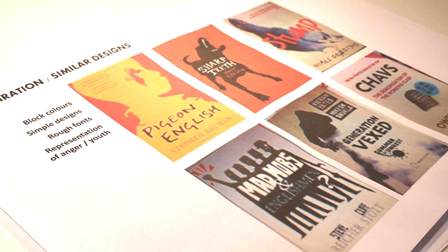First off, a confession: I didn't do this for my first novel. Bizarrely, it hit number 2 on Amazon anyway, due to various pieces of press coverage (which I'll talk about in my Getting Press Coverage post), but I can't help wondering whether it might have made it to the top-spot if I'd known then what I know now about cover design.

As I say in my video, authors should not design their own book covers. There are no exceptions. Even if you're a designer by trade, you should get a fresh pair of eyes on the project - a designer friend, perhaps - if you can't afford the £500-£1,000 it'll cost you to get a professional to design the full wrap-around cover and thumbnail.
A word of warning up front: If you're calling in favours from a friend who knows a bit about design, make sure he or she understands book cover design. There are a whole load of book-specific rules around fonts, layout, margins, kerning and other mysterious things that I'm not going to talk about here, which your designer should live and breathe so that you don't have to. (You're heading up the publishing house, remember - not doing everything inside it!)
Hopefully I've convinced you to collaborate with a book cover designer. So… where will you find such a person? Well, one way is to wander round your nearest book store (or Amazon, if you prefer things virtual) and pick out a few designs you like the look of. Turn the book over (or click to expand the thumbnail) and you'll see the name and/or website of the designer, somewhere near the barcode. Beware: Some designers won't take on independent commissions and some might be out of your price range, but if you dig around, you should find someone suitable.
Alternatively, there are lots of marketplace websites, this being one of them, which aim to match authors with service providers such as cover designers. Make sure you get genuine testimonials from previous clients and of course, only go with a designer who has worked on books of a similar style or genre. If someone has spent their life designing sci-fi novel jackets, it's unlikely to be a good match for a romance writer.
Getting the right designer is the hardest and most important part. Once you've done this, you need to get him or her to understand your book and the vision you have for it. In an ideal world, your designer would read the book, but at the very least, sit down and talk it through. Show him or her any examples of books in a similar style and share any thoughts you have on colours, themes, fonts etc. Don't be too prescriptive. The designer should have the freedom to come up with ideas!
As you'll see in the video, coming up with the perfect design is an iterative process. You will hopefully start with a few different options, then narrow it down to one core concept, which you can collaboratively hone until you have the perfect layout, colours, fonts, spacing and so on. One of the great things about self-publishing is that you can liaise directly with your designer, rather than being at the mercy of a committee of marketers, editors and other people who haven't read your book.
Test out your concepts! This is a great way of getting potential readers to engage with your project ahead of publication. I often put the shortlist up on my Facebook page for fans to compare. You'd be amazed at how differently people perceive the designs and you might find that the artwork is giving off entirely the wrong vibes. It's better to learn this now than when the Amazon reviewers are complaining about being misled.
As I say in my video, it's only when you have the perfect front cover (which needs to work as a small thumbnail as well as at scale) that your designer will work on the full wrap-around cover. For this, you'll need your back-of-book 'blurb', which I'll talk about in my next post, Publishing Your Book. In reality, you'll probably do all these things simultaneously, working with your editor(s) to produce your final draft, collaborating with your designer to get the perfect cover, agreeing on your publishing and distribution while planning your marketing. It's not as arduous as it sounds - promise! Next time I'll be talking about the mechanics of publishing, i.e. getting your book on the shelves, both physical and virtual. Until then… good luck!
Polly Courtney is the author of six novels, both self-published and traditionally published. In 2011, she walked out on her publisher, HarperCollins, in protest at the chick-lit branding of her books. She is currently working on the film adaptation of her latest novel, Feral Youth - the story of the London Riots through the eyes of a 15-year-old girl. She is a firm advocate of self-publishing, but only when it's done well.
Comments